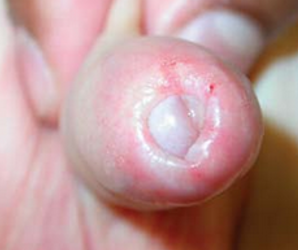- Refers to the condition when the foreskin (prepuce) cannot be retracted over the glans penis.
 |
 |
May be physiologic
- Due to normal adhesion of the foreskin to the glans.
- Common in male children up to 3 years of life.
- Can be seen even into the teenage years.
- Does not require surgical correction.
|
May be pathologic
- Due to scar tissue formation that prevents retraction of the foreskin.
- Often associated with:
- commonly due to repeated attempts to forcibly retract the foreskin before it has become naturally retractable
- Recurrent balantitis or balanoposthitis
- Balanitis Xerotica Obliterans (BXO) from penile lichen sclerosis an aggressive scarring condition (very rare <8 yo)
- Requires correction and, potentially, circumcision.
|
- Normal tissue adhesions prevent full retraction.
- There is no scar tissue.
- The preputial outlet is always closed and the glans is not visible, unless retractile force is applied to foreskin (and then only a small area of the glans, if any, is visible).
- With gentle retractile force, the inner mucosal surface everts through outlet. [McGregor, 2007]
- Said to “Open like a Flower” (the visual image is odd).
- Ballooning can be seen with physiologic phimosis.
- Occurs due to a tight orifice, but a distensible preputial sac.
- Urination leads to ballooning of the prepuce.
- Not found to be associated with obstructive voiding and not a mandate for circumcision. [Babu, 2004]
|
- Scar tissue prevents retraction of the foreskin.
- The scar tissue will often hold the preputial outlet open, exposing a portion of the glans without retractile force being applied.
- Inner mucosal will not evert through the outlet when retractile force applied.
Features
- Obvious ring of scar tissue visible at foreskin opening
- Foreskin not retractable at the conclusion of puberty
- Previously retractable foreskin becomes non-retractable
- Persistent ballooning of foreskin on urination in older children, with pinhole foreskin opening, narrow urinary stream and no response to topical steroid creams
-
|
| Management |
-
- Education and reassurance!
- Hygiene
- Families and children should be taught to GENTLY retract the foreskin to the point of resistance during bathing and urination.
- It should not be forcefully retracted (as this may lead to scarring!). [McGregor, 2007]
- 6-8 week course of topical steroids can help accelerate the normal process if this is desired.
- 0.05% betamethasone
- 0.1% triamcinolone
-
- applied to preputial outlet BID
- If no / poor response to steroids, pathologic phimosis is likely. Refer to Urology services
|
- Circumcision is the default answer, but…
- Steroids have been shown to be effective in cases of mild scarring and can help avoid circumcision.
- If phimotic ring persists after steroid therapy, then circumcision is necessary. [Esposito, 2008]
|
Red flag: urgent surgical referral is required is the child is unable to pass urine
Related